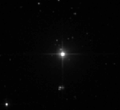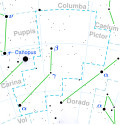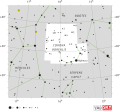 | A debris disk (American English), or debris disc (Commonwealth English), is a circumstellar disk of dust and debris in orbit around a star. Sometimes... 27 KB (2,357 words) - 13:42, 31 December 2023 |
 | Zeta Reticuli (section Alleged debris disk) coming from a two-lobed structure that looked like a debris disk seen edge-on. This debris disk interpreted as an analogy to the Kuiper belt with a semi-major... 24 KB (2,125 words) - 02:46, 13 February 2024 |
 | White dwarf (section Debris disks and planets) the white dwarf, until it will eventually sublimate and the disk will disappear. A debris disk will have a lifetime of around a few million years for white... 160 KB (18,161 words) - 19:57, 9 April 2024 |
 | Vega (category Circumstellar disks) have a circumstellar disk of dust. This dust is likely to be the result of collisions between objects in an orbiting debris disk, which is analogous to... 90 KB (9,509 words) - 14:34, 12 April 2024 |
 | Pulsar planet (section Debris disks and precursors) interaction with a more massive one; the light white dwarf gives rise to a debris disk that generates a planet while the larger white dwarf becomes a pulsar... 45 KB (5,288 words) - 20:27, 19 April 2024 |
piece of space debris falling to Earth leaves a fiery trail, just like a meteor. A debris disk is a circumstellar disk of dust and debris in orbit around... 9 KB (1,138 words) - 19:50, 21 April 2024 |
 | AU Microscopii (category Circumstellar disks) star. Like β Pictoris, AU Microscopii has a circumstellar disk of dust known as a debris disk and at least two exoplanets, with the presence of an additional... 35 KB (2,849 words) - 20:25, 19 April 2024 |
HD 69830 (section Debris disk) were updated in 2023. In 2005, the Spitzer Space Telescope detected a debris disk in the HD 69830 system consistent with being produced by an asteroid... 15 KB (1,284 words) - 19:49, 31 December 2023 |
 | Fomalhaut (category Circumstellar disks) by several debris disks. The inner disk is a high-carbon small-grain (10–300 nm) ash disk, clustering at 0.1 AU from the star. Next is a disk of larger... 48 KB (4,575 words) - 13:06, 20 April 2024 |
HD 98800 (category Circumstellar disks) 98800 A and HD 98800 B each of which contains two stars. In 2007, a debris disk was discovered orbiting HD 98800 B consisting of two rings which indicates... 19 KB (1,780 words) - 06:37, 19 January 2024 |
 | HR 8799 (category Circumstellar disks) 9 times its luminosity. It is part of a system that also contains a debris disk and at least four massive planets. Those planets, along with Fomalhaut... 43 KB (3,971 words) - 18:40, 10 March 2024 |
Gliese 581 (redirect from Gliese 581's debris disk) three planets discovered using the radial velocity method, along with a debris disk. The system's notability is due primarily to early exoplanetology discoveries... 47 KB (4,960 words) - 04:29, 22 December 2023 |
 | Tau Ceti (category Circumstellar disks) be a Jovian planet between 3 and 20 AU from the star. Because of its debris disk, any planet orbiting Tau Ceti would face far more impact events than... 62 KB (6,827 words) - 17:05, 20 April 2024 |
 | Beta Pictoris (category Circumstellar disks) use of direct imagery. Both planets are orbiting in the plane of the debris disk surrounding the star. Beta Pictoris c is currently the closest extrasolar... 57 KB (6,099 words) - 22:44, 2 February 2024 |
 | 61 Virginis (section Debris disk) wavelength of 160 μm. This indicated the presence of a debris disk in orbit around the star. This disk was resolved at 70 μm. It was then thought to correspond... 21 KB (1,931 words) - 18:15, 26 January 2024 |
 | planet exists such that it has created those accumulations. Disks of space dust (debris disks) surround many stars. The dust can be detected because it... 131 KB (14,970 words) - 18:52, 20 April 2024 |
 | HR 4796 (category Circumstellar disks) an excess of infrared emission, implying that it has a circumstellar debris disk. Observations using the Near-Infrared Multi-Object Spectrometer aboard... 15 KB (1,300 words) - 03:37, 29 November 2023 |
 | Circumstellar disc (redirect from Circumstellar disk) longer than one month showed typically a misalignment of the disk with the binary orbit. Debris discs consist of planetesimals along with fine dust and small... 24 KB (2,947 words) - 02:11, 14 March 2024 |
 | NGC 2547 (section Cluster members with debris disks) ID8 is located in NGC 2547 and showed substantial brightening of the debris disk at a wavelength of 3 to 5 micrometers, followed by a decay over a year... 10 KB (1,059 words) - 00:21, 3 December 2023 |
 | Epsilon Eridani (category Circumstellar disks) Eridani. The observations indicated a disk of fine-grained cosmic dust was orbiting the star; this debris disk has since been extensively studied. Evidence... 119 KB (11,442 words) - 02:16, 12 April 2024 |
 | 161 planetary systems, with 896 systems having more than one planet. Debris disks are also known to be common, though other objects are more difficult... 47 KB (5,449 words) - 02:42, 6 January 2024 |
Glossary of astronomy (redirect from Tidal debris) debris disk A ring-shaped circumstellar disc of dust and debris orbiting its host star. It is created by collisions between planetesimals. A debris disk... 160 KB (18,354 words) - 13:10, 19 April 2024 |
 | Planetesimal (category Circumstellar disks) /plænɪˈtɛsɪməlz/ are solid objects thought to exist in protoplanetary disks and debris disks. Believed to have formed in the Solar System about 4.6 billion years... 11 KB (1,152 words) - 06:33, 19 March 2024 |
 | Gamma Trianguli (section Debris disk) Orbiting the star is a dusty debris disk with a combined mass of about 2.9 × 10−2 times the mass of the Earth. This disk can be detected because it is... 11 KB (822 words) - 12:01, 14 May 2023 |
 | Disrupted planet (category Circumstellar disks) and debris, which may eventually surround the parent star in the form of a circumstellar disk or debris disk. As a consequence, the orbiting debris field... 15 KB (1,423 words) - 07:51, 18 March 2024 |
the core behind. This crust and mantle material would then form the debris disk, which is now detected around the white dwarf. At first the size of the... 5 KB (505 words) - 19:32, 21 April 2024 |
 | out of a nebula to create a young protostar orbited by a protoplanetary disk. There are eight planets within the Solar System; planets outside of the... 8 KB (781 words) - 19:19, 18 April 2024 |
brown dwarf or gas giant exoplanet. It is a substellar companion of the debris disk host star HR 2562. HR 2562 is a sixth-magnitude F-type main-sequence... 5 KB (450 words) - 12:15, 4 April 2024 |


